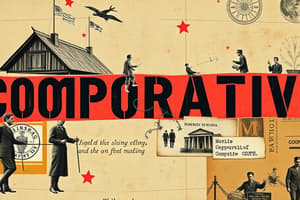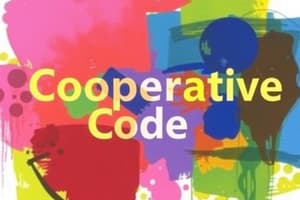Podcast
Questions and Answers
What was the principal aim of the bill sponsored by Albert Barreto in the lower House of Congress?
What was the principal aim of the bill sponsored by Albert Barreto in the lower House of Congress?
To protect and develop the agricultural interest of the country.
What title did Gov. Sandiko earn after the Rural Credit Law was enacted?
What title did Gov. Sandiko earn after the Rural Credit Law was enacted?
Father of Cooperation.
When was the Agricultural Credit Cooperative Association of Cabanatuan formed?
When was the Agricultural Credit Cooperative Association of Cabanatuan formed?
October 18, 1916.
What percentage of rural cooperatives were inactive by 1935?
What percentage of rural cooperatives were inactive by 1935?
What was the purpose of the Cooperative Marketing Law enacted in 1927?
What was the purpose of the Cooperative Marketing Law enacted in 1927?
How many rural credit associations were organized by the end of 1926?
How many rural credit associations were organized by the end of 1926?
What happened to the number of cooperative marketing associations by 1939?
What happened to the number of cooperative marketing associations by 1939?
What significant event occurred in 1940 regarding cooperatives in the Philippines?
What significant event occurred in 1940 regarding cooperatives in the Philippines?
Who succeeded Rep. Albert Barreto in sponsoring the rural credit bill in the Second Philippine Legislature?
Who succeeded Rep. Albert Barreto in sponsoring the rural credit bill in the Second Philippine Legislature?
What was the fate of the rural financing experiment through cooperatives by the early 1930s?
What was the fate of the rural financing experiment through cooperatives by the early 1930s?
How did Dr. Jose P. Rizal's travels in Europe influence his views on cooperatives?
How did Dr. Jose P. Rizal's travels in Europe influence his views on cooperatives?
What was the primary goal of Rizal's planned colony in Sandakan, Borneo?
What was the primary goal of Rizal's planned colony in Sandakan, Borneo?
What actions did Rizal take in Dapitan to promote cooperative practices?
What actions did Rizal take in Dapitan to promote cooperative practices?
What was 'La Sociedad de los Abacaleros' and how long did it function?
What was 'La Sociedad de los Abacaleros' and how long did it function?
Who was Teodoro Sandiko and what was his relation to the cooperative movement?
Who was Teodoro Sandiko and what was his relation to the cooperative movement?
What type of cooperative did Sandiko aim to introduce in the Philippines?
What type of cooperative did Sandiko aim to introduce in the Philippines?
What role did the American Civil Government play in fostering Filipino participation and cooperatives?
What role did the American Civil Government play in fostering Filipino participation and cooperatives?
What challenges did Rizal face in pursuing his cooperative goals?
What challenges did Rizal face in pursuing his cooperative goals?
Flashcards
Rizal's Cooperative Influence
Rizal's Cooperative Influence
Inspired by European movements, he sought to establish a cooperative colony in Sandakan, Borneo.
Rizal's Dapitan Cooperative
Rizal's Dapitan Cooperative
He established a cooperative school and store in Dapitan for the local community.
La Sociedad de los Abacaleros
La Sociedad de los Abacaleros
A group for abaca producers organized by Rizal in Dapitan. It lasted one year and returned shares without losses to members.
Teodoro Sandiko
Teodoro Sandiko
Signup and view all the flashcards
Sandiko’s Cooperative Bill
Sandiko’s Cooperative Bill
Signup and view all the flashcards
February 11, 1914
February 11, 1914
Signup and view all the flashcards
Bureau of Agriculture
Bureau of Agriculture
Signup and view all the flashcards
Agricultural Credit Cooperative Association
Agricultural Credit Cooperative Association
Signup and view all the flashcards
College of Agriculture, Los Baños
College of Agriculture, Los Baños
Signup and view all the flashcards
Cooperative Marketing Law (Act 2425)
Cooperative Marketing Law (Act 2425)
Signup and view all the flashcards
Commonwealth Act No. 565
Commonwealth Act No. 565
Signup and view all the flashcards
Teodoro Sandiko
Teodoro Sandiko
Signup and view all the flashcards
Study Notes
Historical Context of Philippine Cooperatives
- Dr. Jose P. Rizal was influenced by European economic movements during his travels, especially concerning cooperation.
- In 1892, Rizal sought to establish a cooperative colony in Sandakan, Borneo, inspired by Robert Owen's plans, but was arrested and exiled to Dapitan.
Rizal's Contributions
- In Dapitan, Rizal established a cooperative school and store for the local poor community.
- He organized the La Sociedad de los Abacaleros, a group for abaca producers, which lasted one year but returned shares without losses to members.
Teodoro Sandiko and the Raiffeisen Movement
- Teodoro Sandiko, inspired by the Raiffeisen cooperative model in Germany, aimed to introduce similar systems in the Philippines.
- As Bulacan's governor during the American Civil Government, Sandiko drafted a bill for a Raiffeisen-type credit union to aid agricultural interests.
Legislative Milestones
- Sandiko’s bill, sponsored by Rep. Albert Barreto, aimed at supporting farmers, passed unanimously on January 20, 1908, but was initially rejected by the Philippine Commission.
- The bill was reintroduced and successfully passed on February 11, 1914, becoming Act 2508, establishing a formal rural credit system in the Philippines.
Establishment of Rural Credit Associations
- The Bureau of Agriculture managed the Rural Credit Law, leading to the first rural credit association, the Agricultural Credit Cooperative Association, formed on October 18, 1916.
- By 1926, 544 rural credit cooperatives existed across 42 provinces, though by 1930, many were inactive, reflecting a failure in rural financing.
Emergence of Consumer Cooperatives
- The first Consumers Cooperative was launched at the College of Agriculture, Los Baños in 1916.
- The Cooperative Marketing Law (Act 2425) was enacted on December 9, 1927, to enhance the marketing capabilities of farmers.
Decline of Cooperative Associations
- Despite initial enthusiasm for cooperative marketing, only 164 societies were organized by 1939, representing 5,000 farmers, with only 20% active.
- Commonwealth Act No. 565 passed in 1940, giving legal status to Credit and Consumers Cooperatives.
Legacy of Cooperation in the Philippines
- Sandiko is recognized as the “Father of Cooperation” in the Philippines due to his significant role in establishing cooperative legislation and systems.
Studying That Suits You
Use AI to generate personalized quizzes and flashcards to suit your learning preferences.




